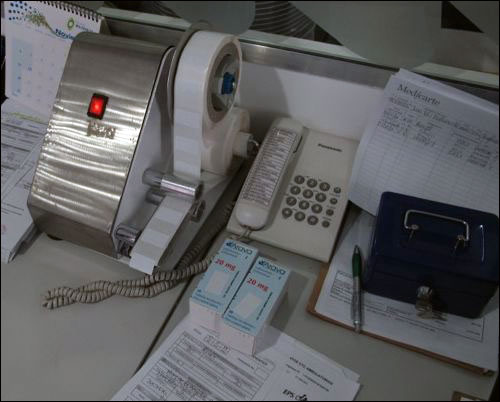Dec 20, 2011Colombian pharmacy chain Medicarte has introduced a radio frequency identification solution designed to track the packaging of expensive cancer-treatment and hormone-replacement drugs, in order to ensure that discarded packaging is not reused by companies attempting to sell counterfeit pharmaceuticals.
"Since the medicines we provide are very expensive for our health-care system, and there is a big black market for these drugs, we wanted to contribute to controlling this black market," says Angela Maria Durango, Medicarte's regional coordinator. "We wanted to obtain the traceability data to know who we were giving the medicines to, and that this same person returned us that same empty medicine package, using RFID and biometric technologies."

The system was developed for Medicarte by IDlink, an RFID solutions provider based in Medellín, Colombia. When a Medicarte pharmacy receives a batch of pharmaceuticals from a drug company, a Tagsys RFID high-frequency (HF) passive transponder, based on the ISO 15693 air-interface protocol standard, is affixed to each item's packaging.
A Tagsys LP-101 RFID reader with an Aero LC antenna under the tagging station interrogates each tag's pre-encoded serial number. A Medicarte employee then enters the type of drug into software also developed by IDlink, along with the expiration date for that batch of medicines.
Patients are asked to return the packaging when they come back for a drug refill. This is not required by law, the company notes, but insurance companies want to reduce counterfeiting because bogus drugs drive up health-care costs (since counterfeit medicines may not speed up the recovery of patients who consume them, and many actually cause additional harm), so they encourage customers to return the empty packages.
To refill the prescription, the patient places a finger on the scanner, and that person's biometric data is compared with the scan already on file. The package's RFID tag is then interrogated using the Omnikey reader. Software confirms the patient's identify, and determines whether the package tag's serial number matches that of the packaging originally issued to the patient.
"We are closing the loop and ensuring that the empty package can not be refilled with a counterfeit product that is then sold on the street," says Juan Carlos Ramirez, IDlink's director of business development. "Right now, Medicarte is only tagging cancer medicine, some growth hormones and a few other expensive pharmaceuticals. The drugs are tagged in the pharmacy, and the empty packaging is returned to the pharmaceutical company."
According to Ramirez, the system has helped Medicarte to uncover several instances in which a patient package different than the one originally provided to that person. "We're starting to pinpoint those problems, thanks to RFID," he states.
The system is currently live in the cities of Bogotá, Cali, Medellín, Barranquilla, Pereira and Manizales. The software is cloud-based, and is integrated with Medicarte's enterprise resource planning (ERP) software. Prior to deploying the RFID system, the firm's pharmacists manually marked medicines using a piece of colored adhesive tape, then recorded by hand how a specific dose for a particular patient was marked. This enabled the company to determine if it received the same package originally provided to that patient. According to Medicarte, RFID greatly reduces both the manual mistakes involved, and the potential for human error.
"RFID has helped us streamline some internal processes," Durango says. "Although some time is invested at the beginning of the process, when we tag the medicines we receive from suppliers, that time is recovered when we are dispensing drugs to patients, and when we receive the empty packages back."
"I think that for further expansion of the system, it is fundamental that the pharmaceutical companies get involved," Durango states. "Specialty medicines should come RFID-tagged from the pharmaceutical company's distribution center."
In 2012, Medicarte plans to utilize cell phones equipped with Near Field Communication (NFC), a form of RFID technology, to enable drug delivery to a patient's home. The person delivering the drugs would scan that medication's passive HF transponder at the recipient's residence. Software running on the phone would forward the transponder's serial number to Medicarte's ERP system, along with the phone's GPS coordinates, thereby confirming that the correct drug was delivered to the proper address.

